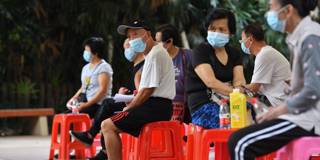For more than two years, the Chinese government has stamped out COVID-19 infections wherever they have appeared, even when it has meant locking down megacities like Shanghai for months at a time. To move away from this unsustainable policy, it will need to convince a wary population to get vaccinated.
ROME – China’s urban populations have been enduring some of the most intense infection-prevention measures of the COVID-19 pandemic. For 60 straight days, Shanghai’s 27 million residents were forced into a strict lockdown – and they were not alone. During the peak of the Omicron BA.2 wave in April and May, 45 cities with a total of 373 million people were under some sort of lockdown. That is more than the combined populations of the United States (329.5 million) and Canada (38 million), and 83% of the population of the European Union (447 million).
China’s “zero-COVID” strategy has wreaked havoc on its economy and its people. But the Omicron wave has also highlighted its elderly population’s continuing vulnerability to the virus. As of June 2, 40% of those over 60 – around 95 million people – had not received any doses of a COVID-19 vaccine, even though they are at higher risk of severe illness and death from the disease.
One reason for the low vaccination rate is that the Chinese population has simply grown accustomed to the low rates of COVID-19 infections over the past two years. Now that the Omicron wave has struck, the higher perceived risk of remaining unvaccinated should increase vaccination among the elderly somewhat.

ROME – China’s urban populations have been enduring some of the most intense infection-prevention measures of the COVID-19 pandemic. For 60 straight days, Shanghai’s 27 million residents were forced into a strict lockdown – and they were not alone. During the peak of the Omicron BA.2 wave in April and May, 45 cities with a total of 373 million people were under some sort of lockdown. That is more than the combined populations of the United States (329.5 million) and Canada (38 million), and 83% of the population of the European Union (447 million).
China’s “zero-COVID” strategy has wreaked havoc on its economy and its people. But the Omicron wave has also highlighted its elderly population’s continuing vulnerability to the virus. As of June 2, 40% of those over 60 – around 95 million people – had not received any doses of a COVID-19 vaccine, even though they are at higher risk of severe illness and death from the disease.
One reason for the low vaccination rate is that the Chinese population has simply grown accustomed to the low rates of COVID-19 infections over the past two years. Now that the Omicron wave has struck, the higher perceived risk of remaining unvaccinated should increase vaccination among the elderly somewhat.